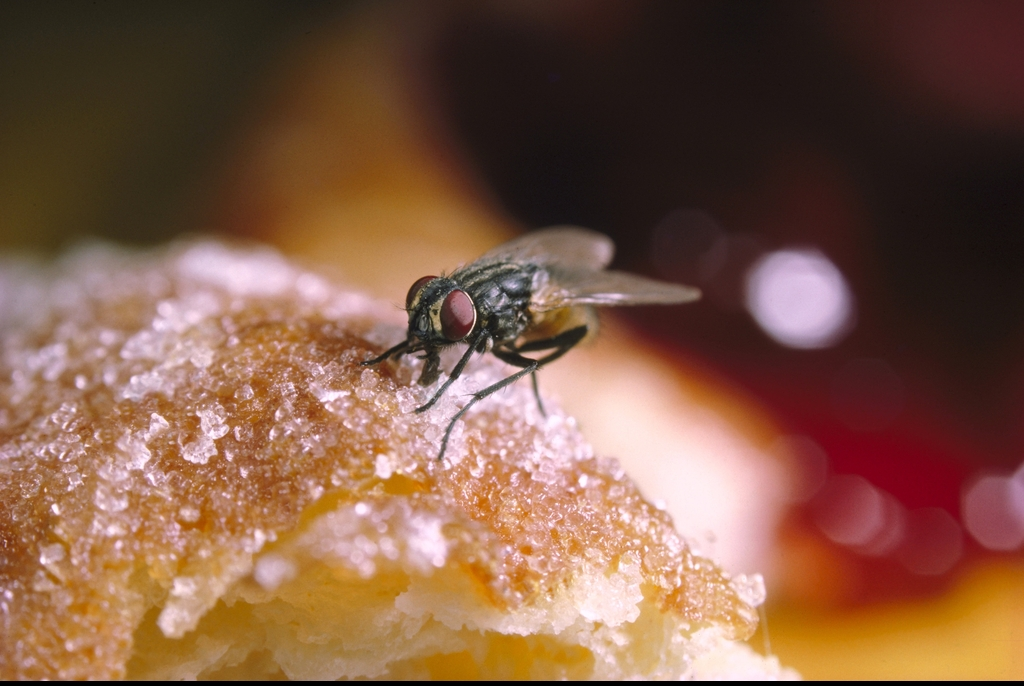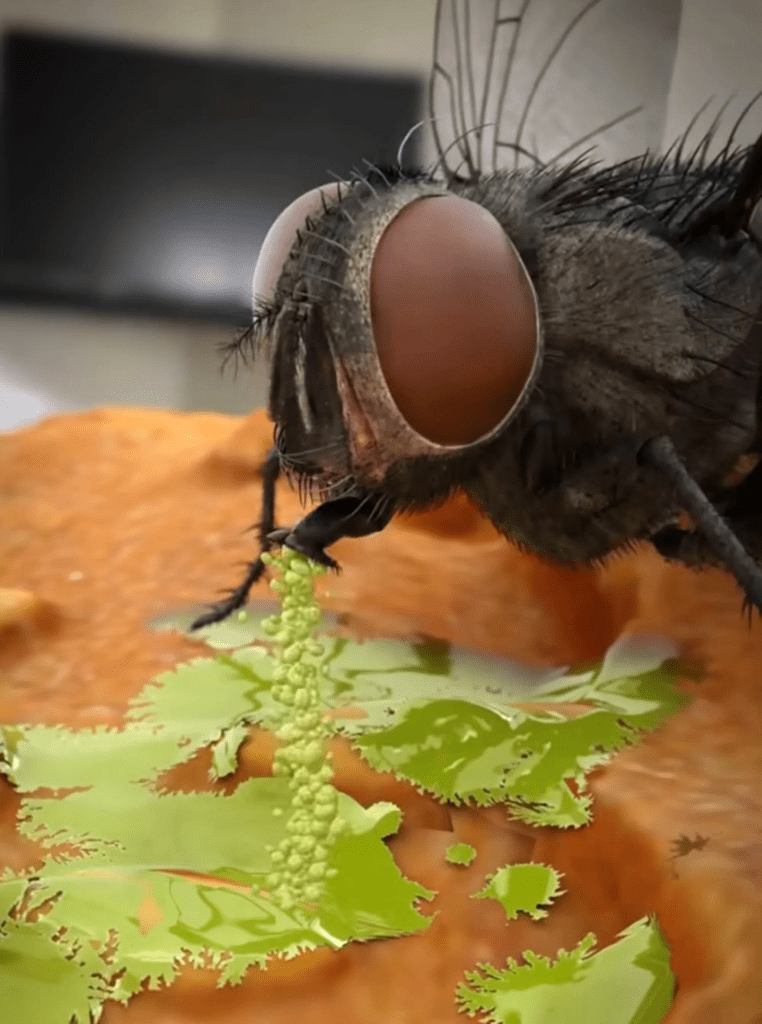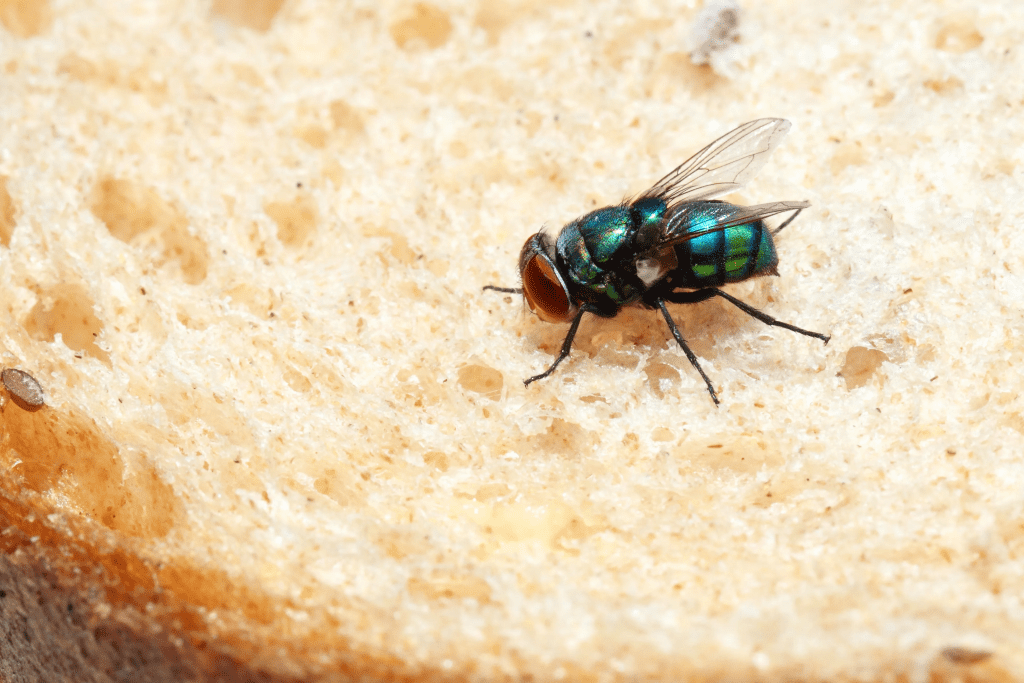Flies might seem like minor nuisances, buzzing around and occasionally landing on your plate. But the reality of what happens when a fly touches your food is far more alarming than you might think. Thanks to a viral simulation shared by YouTuber Zack D. Films, millions of viewers have been horrified to discover the unsettling truth. Let’s dive into the science and the social buzz around this stomach-churning revelation.
What Really Happens When a Fly Lands on Your Food?

Flies don’t just casually rest on your food—they actively alter it in ways that could make anyone lose their appetite. Unlike humans, flies lack teeth. To consume food, they employ a unique process that involves regurgitating saliva filled with digestive enzymes onto the surface of the food. This liquid breaks down the food into a semi-digestible substance that the fly can then slurp up with its sponge-like mouthparts.
Essentially, every time a fly lands on your food, it’s not just sitting there—it’s vomiting on it. And while that alone is gross, it’s only the tip of the iceberg.
The Hidden Threat: What Flies Bring to Your Food
Flies are notorious for their love of unsanitary places like garbage bins, feces, and decaying matter. As they hop from surface to surface, they pick up bacteria, viruses, and other harmful microorganisms. When they land on your food, they transfer these pathogens via their saliva, legs, and tiny hairs.
This process, invisible to the naked eye, contaminates your food with harmful bacteria such as salmonella, E. coli, and cholera. Even a brief landing can turn your meal into a potential health hazard, especially if the fly has been in particularly dirty environments.
The Internet Reacts to the Fly Food Simulation
Zack D. Films’ simulation, which graphically illustrated the contamination process, has sparked widespread disgust across social media. Users flooded comment sections with their reactions, ranging from horror to reluctant acceptance.
One commenter exclaimed, “I will never eat food that a fly has touched again. New fear unlocked!” Another admitted, “I’ve been more mindful about flies since seeing this. It’s a game-changer for how I handle my meals.”
Of course, not everyone was fazed. A few shrugged it off, with one saying, “I’ve survived worse; flies don’t scare me!” But for many, the simulation served as a wake-up call to take food hygiene more seriously.
Flies Taste Your Food with Their Feet
As if vomiting on your food weren’t bad enough, flies also “taste” your meal before eating it. Flies have specialized taste receptors located on their feet, called chemosensilla, which allow them to sample the food upon landing.
This means that before a fly even begins its digestion process, it’s already contaminating your food simply by stepping on it. Their tiny legs and feet often carry bacteria from their previous stops, adding to the cocktail of germs they deposit on your plate.
The Risk of Maggots: Flies May Leave Behind Eggs
Under the right conditions, flies don’t just vomit on your food—they may also lay eggs. These eggs can hatch into maggots within hours, particularly in warm environments. Pest control experts warn that food exposed to flies should be discarded immediately, as maggots indicate a severe level of contamination.
The idea of finding wriggling maggots in your meal is enough to make anyone think twice about brushing off a fly landing as harmless.
Flies as Disease Carriers: The Real Danger

Flies are far more than annoying—they’re vectors for serious diseases. They can carry pathogens that cause illnesses ranging from mild food poisoning to life-threatening conditions. Among the diseases flies are known to spread are:
- Salmonella
- E. coli
- Cholera
- Dysentery
- Tuberculosis
Even a brief contact with your food is enough for a fly to transfer these pathogens, making it critical to take precautions whenever flies are around.
How to Keep Flies Away from Your Food

The best way to avoid the health risks posed by flies is to prevent them from landing on your food in the first place. Here are some practical tips:
- Cover Your Food: Use lids, aluminum foil, or mesh food covers to protect meals during preparation or outdoor dining.
- Maintain a Clean Eating Area: Regularly clean surfaces to eliminate crumbs and food residue that attract flies.
- Use Natural Repellents: Herbs like basil, mint, and lavender naturally repel flies and can be placed near dining areas.
- Set Up Fly Traps: Simple homemade or store-bought fly traps can reduce their presence in your home.
- Act Quickly: If a fly lands on your food, inspect it closely and consider discarding the affected portion.
Should You Eat Food Touched by a Fly?
The risk depends on where the fly has been and how long it lingers. If a fly has only briefly landed on your food and you’re confident it hasn’t come from a dirty environment, the risk of harm is lower—but not zero. However, if there’s any doubt about the fly’s cleanliness, it’s better to err on the side of caution and discard the food.
Conclusion: Why Flies Deserve More Attention
Flies may be tiny, but their impact on food safety is anything but insignificant. Each landing brings with it the risk of contamination, turning a seemingly harmless nuisance into a potential health hazard. With knowledge of how flies behave and the risks they pose, we can take steps to better protect ourselves and our meals.
The next time you see a fly buzzing near your plate, think twice about letting it linger. A little vigilance can go a long way in ensuring your food stays safe and germ-free. So, grab that fly swatter and keep your dining spaces protected—your health depends on it.


